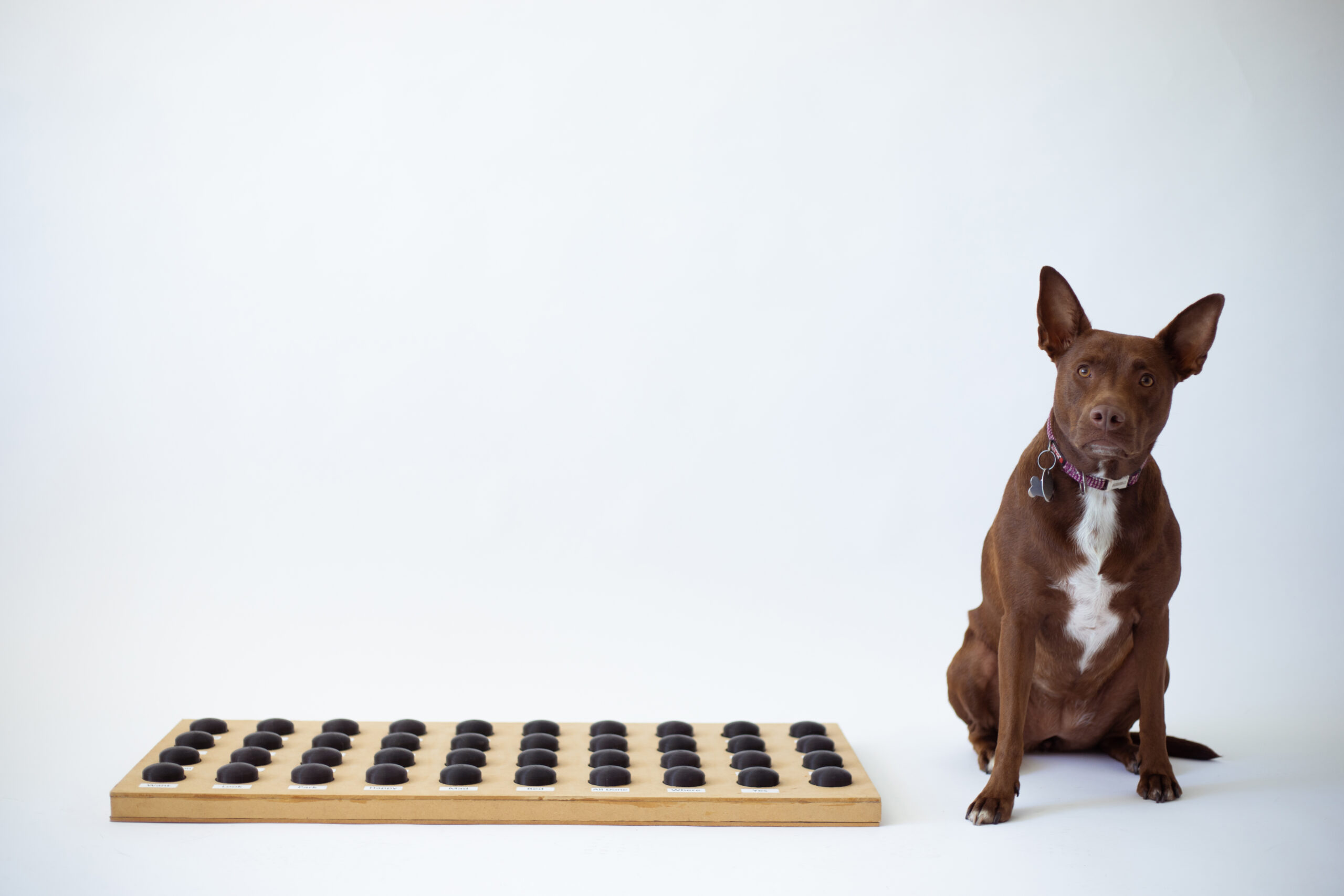Hunger for Words’ button teaching practices are inspired by Language Acquisition through Motor Planning (LAMP), a therapeutic AAC approach.
LAMP combines established language principles to give non-verbal individuals and those with limited speech a method of independently and spontaneously expressing themselves with a speech-generating device.
Christina received LAMP training from The Center for AAC & Autism in 2018.
Below are the five core tenants of the LAMP approach followed by explanations and applications to pets and button communication:
Photo credit: LAMP Words for Life
1. Readiness to Learn
Readiness to learn means being in a state to receive optimal benefit from the learning experience.
Readiness to learn can be illustrated by the Goldilocks Principle, which states that optimal learning occurs when conditions are “just right,” as opposed to too difficult or too easy.
Readiness to learn can be illustrated by the Goldilocks Principle, which states that optimal learning occurs when conditions are “just right,” as opposed to too difficult or too easy.
The three factors we are looking to get “just right” are the learner’s state of mind, the task, and the environment.
- State of Mind: A learner who is overly excited, fixated, or distracted is not in the best state of mind to learn because learning is best facilitated by focused attention.
- Task: Similarly, learning interactions should be learner-centric. If the learner can’t find value, motivation, or relevance in the task, they are less likely to engage in the process or connect meaningfully with the information received.
- Environment: The environment should be calm and quiet when teaching new concepts. An overly noisy or chaotic environment may hinder our pet’s ability to focus.
2. Joint Engagement
Joint Engagement is two individuals participating in the same activity or interacting with the same object. The greatest gains in joint engagement seem to occur when interactions are learner-directed or learner-led, meaning the learner has autonomy and agency as opposed to being told what they have to do.
Hunger for Words’ primary technique for teaching button communication is a form of social learning called modeling. In modeling, the teacher demonstrates the behavior they want their learner to imitate, in this case pushing a particular button. Joint attention is crucial to modeling success.
A good test of joint attention is whether a learner chooses to “stay in the game,” demonstrating appropriate interest and attending to the interaction as opposed to being reluctant or unwilling to participate or playing their own game independent of the teacher.
To promote learner-led joint engagement, build on the learner’s interests and avoid frustrating or boring them. Multiple, short teaching sessions per day are preferable over fewer, long sessions.
Here are some ways to know whether your learner is practicing joint attention:
3. Auditory Signals
Using auditory signals means pressing a button that makes a sound for the corresponding word. This additional sensory input of a voice delivering the word immediately after a button is pressed helps the learner create connections between the button they selected and the corresponding word.
Generally, the more types of sensory feedback that are available when learning a task, the easier the task is to learn. Through the repeated pairing of the two types of sensory input, the unique button selection movement and the subsequent auditory signal, the motor areas of the brain develop speech perception.
The auditory systems of dogs, cats, and humans are very similar, sharing the same basic plan and physical structures. Sound waves are collected in the outer ear and amplified via the middle ear before being converted into electrical signals by the inner ear.
4. Unique and Consistent Patterns
When verbal individuals talk, they do so almost automatically. Because they do not have to concentrate on how to say words, they can focus their attention on other parts of the social interaction.
The same is true for those fluent in AAC. Vocabulary words programmed on the device are organized in a pattern that allows for fast, natural, fluent, automatic communication. Those fluent in AAC have achieved this reflexive level of expression via spatial learning resulting from countless interactions with the communication map that is their AAC device.
There are three stages of motor learning:
- The cognitive stage is the earliest learning stage. Here, the learner will require assistance and may or may not know what she is doing wrong.
- The associative stage is the refining stage. Here, performance is more accurate and the learner will usually be able to detect and correct her own errors.
- In the autonomous stage, AAC communication becomes automatic. She no longer needs to think consciously in order to communicate. She has memorized her device, which allows her to interact while simultaneously paying attention to other aspects of the interaction.
Dogs and cats have excellent propensity for spatial learning and the ability to map spaces and acquire reflexive or automatic behaviors.
5. Natural Consequences
Your response to a word helps your learner understand the word’s meaning. Examples of natural consequences are delivering the requested object, doing the desired activity, or providing another appropriate response.
AAC motor patterns are repeated extensively, and learning is based on the feedback received from the communication partner. When an individual selects a word on their device, their communication partner must react immediately and appropriately with a related natural consequence.
These immediate or nearly immediate natural consequences attach meaning to words. Natural consequences need to be meaningful to the learner, and when they are, they serve to reward, reinforce, and motivate.
Summary
LAMP principles are applicable to humans and animals alike. There are many factors to consider when you are teaching your pet to talk. Following these tenants will lead to a more learner-centric button communication journey and is likely to expedite progress.
For more advanced techniques and tips for teaching your pet to talk, book a coaching session to get personalized guidance directly with Christina!
Inspiration for You and Your Dog


